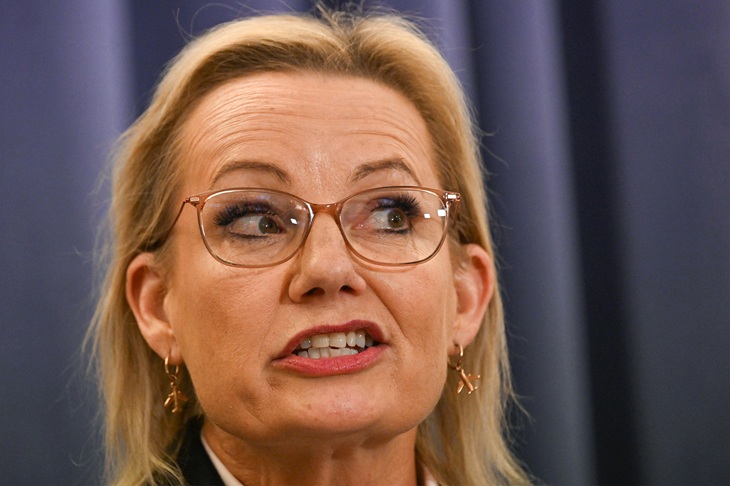
Australia's Leader of the Opposition Sussan Ley speaks at a press conference at Parliament House in Canberra on May 13, 2025. (Photo by Saeed Khan / AFP) (Photo by SAEED KHAN/AFP via Getty Images)
The political landscape in Australia has shifted dramatically, with the latest Redbridge poll revealing a significant decline in support for Deputy Leader of the Liberal Party, Sussan Ley. The Coalition’s primary vote has dropped to an alarming 24 percent, while the minor party One Nation has surged to 18 percent. This shift has prompted reactions from various political factions, highlighting the current instability within the conservative ranks.
The poll results have been met with enthusiasm from left-leaning commentators, who view the numbers as evidence of growing disarray in the Coalition. Ley’s rating as preferred Prime Minister stands at a record low of just 10 percent, a stark contrast to Prime Minister Anthony Albanese, who enjoys a commanding 40 percent approval rating. Ley’s recent policy announcements, including a commitment to abandon Net Zero emissions and a focus on reducing immigration, seem to be efforts to reshape her party’s image amidst dwindling support.
In a country grappling with economic challenges, rising inflation, and debates over immigration policy, Ley’s leadership is under intense scrutiny. Critics argue that her approach fails to resonate with voters, particularly those in outer suburban areas and farming communities who are facing escalating energy crises. Observers note that there is a growing dissatisfaction among conservative voters who are tired of what they perceive as half-hearted measures and political posturing.
Ley’s current leadership struggles have led to speculation about potential challengers within the Coalition. Reports indicate that some moderates are considering supporting Andrew Hastie, who has been gaining traction among conservative voters. As the Coalition navigates these turbulent waters, the need for a unified conservative front becomes increasingly urgent. Historical trends suggest that conservative parties often achieve electoral success when they surpass 41 percent of the primary vote and secure more first preferences than the Labor Party.
The recent Redbridge poll illustrates the precarious situation for the Coalition, with combined support for Ley’s party and One Nation reaching 42 percent. While this figure exceeds the critical threshold, the path to victory remains fraught with challenges. Ley’s leadership style, described by some as lacking conviction, has raised concerns about whether she can effectively rally the conservative base.
One Nation’s rise mirrors previous political shifts seen in other countries, drawing parallels with the UK’s Reform Party. The emergence of this party as a viable alternative is not only a concern for the Coalition but also poses challenges for the Labor Party. Albanese’s government is currently facing its own difficulties, grappling with the consequences of its migration policies, which have stirred public discontent and fueled inflation.
Despite the prevailing narrative that the Coalition is unelectable, historical precedents remind us of the unpredictability of politics. Former Prime Minister John Howard, once dismissed as “Mr. 18 percent,” managed to turn his fortunes around and lead his party to victory. The current situation underscores the importance of addressing voter concerns, particularly around economic issues, which continue to dominate public discourse.
While Ley remains at the helm, her ability to navigate this political crisis will determine the Coalition’s future. The party must confront its internal divisions and adopt a more cohesive strategy to appeal to conservative voters. As the political landscape evolves, the next steps taken by Ley and her party could reshape the trajectory of Australia’s governance.
The discontent among voters seeking robust leadership is palpable. The challenge for Ley and her colleagues is to demonstrate conviction and decisiveness, moving beyond mere electoral tactics. In a time when many Australians are yearning for genuine representation, the question remains: can the Coalition rise to the occasion, or will it continue to falter under the weight of its internal struggles? The coming months will be crucial in determining the future of both the Coalition and the broader conservative movement in Australia.






